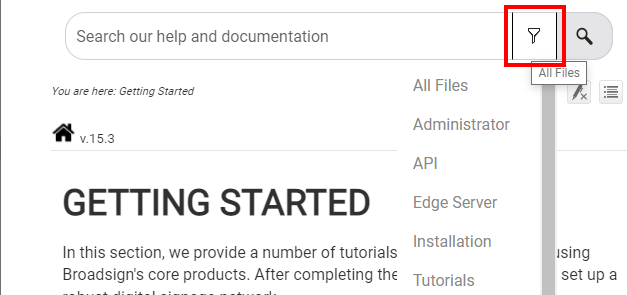The Suspend or Resume actions allow dynamic content to interrupt existing content at varying times and under varying conditions. You can call the Suspend or Resume actions directly within HTML5 or through third-party scripts.
Example: If you have screens in a cinema, you could suspend menu content to play movie trailers at scheduled times.
The following Suspend actions are available:
- suspend – Interrupts Broadsign Control Player playback.
- screen_suspend – Interrupts Broadsign Control Player playback and sends a signal to the attached monitor to put it into suspend mode.
The following Resume actions are available:
- resume – Resumes Broadsign Control Player playback.
- screen_resume – Resumes Broadsign Control Player playback and sends a signal to the attached monitor to get it out of suspend mode.
Call the suspend, screen_suspend, resume, and screen_resume actions using one of the following:
WebSocket Server:
-
JSON – You can pass parameters from within your HTML5 file using JSON.
Note: Ensure that you select Enable Remote Control in the Remote Control tab of the configuration profile. See The Remote Control Tab.
Note: If using JSON via the WebSocket server, any firewall present on Broadsign Control Player should be configured to access port 2326 directly for use.
Port 2324:
- remote_action – An application that ships with Broadsign Control Player, using command line.
- XML – If you want to develop your own applications, you can communicate directly with Broadsign Control Player API using XML.
Note: Ensure that you select Enable Remote Control in the Remote Control tab of the configuration profile. See The Remote Control Tab.
Note: Any firewall present on Broadsign Control Player should be configured to either allow bsp.exe to open ports, or configure port 2324 or port 2326 directly for use.
Note: The Triggers Action is the only exception to this rule. It uses port 2325. See Triggers Action.
You can call this action on Windows and Ubuntu Linux, and find it along the following paths:
- Windows (64-bit):
- Ubuntu Linux:
/opt/broadsign/suite/bsp/bin/
C:\Program Files\BroadSign\bsp\bin
To use the command-line remote_action tool, find the executable in Broadsign Control Player’s installation bin directory. For example, to send a screen_suspend command, type:
remote_action.exe screen_suspendWhere:
-
screen_suspend: The action type.
To send a screen_resume command, type:
remote_action.exe screen_resumeA custom application can use the Suspend or Resume actions on Broadsign Control Player by sending an XML message to the monitor_remote port (2324):
<rc version="1" id="1" action="suspend"/>\r\n\r\nNote: You must terminate the request with \r\n\r\n.
The player will respond with the following document:
<!DOCTYPE rc>
<rc version="1" status="1" action="suspend" id="1"/>Note: Each command sent requires a unique identifier (id). The application can use a simple incrementing value here.
Stop Command Action - XML Parameters
Note: Any firewall present on Broadsign Control Player should be configured to either allow bsp.exe to open ports, or configure port 2324 or port 2326 directly for use.
| Parameter | Description |
|---|---|
| id | Contains the identifier of the request. |
| version | The version is always 1. |
| action | The kind of action to be taken, in this case suspend or screen_suspend. |
| status | A result of "1" indicates that the command succeeded. |
A custom application can use the suspend, screen_suspend, resume, or screen_resume actions by sending a JSON message to the WebSocket server of monitor_remote (port 2326). You will need to enable the WebSocket server. For more information, see The Remote Control Tab.
For example:
{
"rc": {
"version": "1",
"id": "1",
"action": "suspend"
}
}Note: Each command sent requires a unique identifier (id). The application can use a simple incrementing value here.
The player will respond with the following document:
{
"rc": {
"version": "1",
"status": "1",
"action": "suspend",
"id": "1"
}
}Suspend/Resume Command Actions - JSON Parameters
Note: If using JSON via the WebSocket server, any firewall present on Broadsign Control Player should be configured to access port 2326 directly for use.
| Parameter | Description |
|---|---|
| version | The version is always 1. |
| status | A result of "1" indicates that the command succeeded. |
| action | The kind of action to be taken, in this case suspend, screen_suspend, resume, or screen_resume. |
| id | Contains the identifier of the request. |

